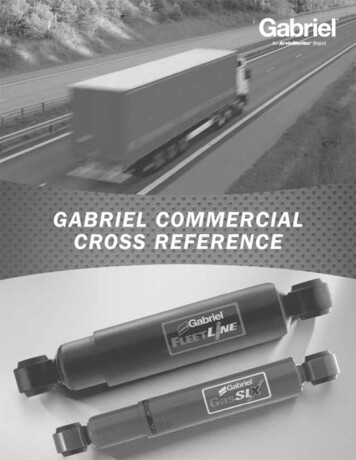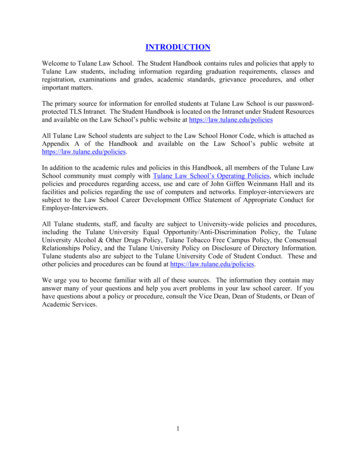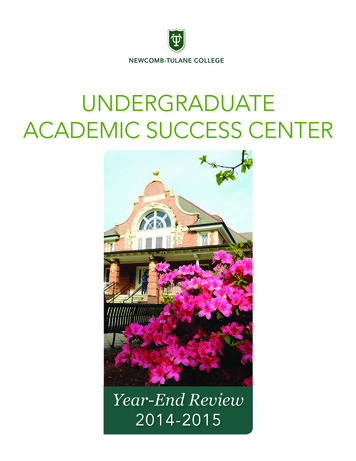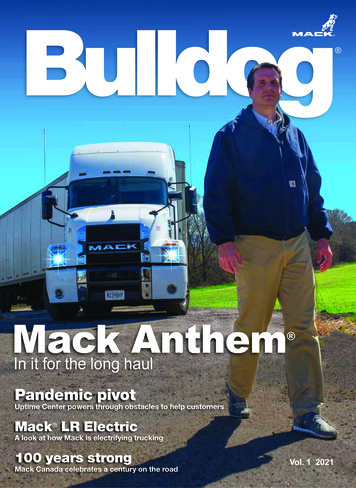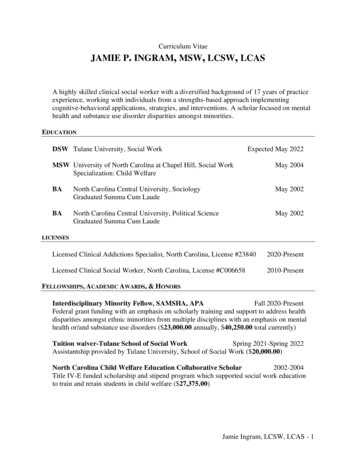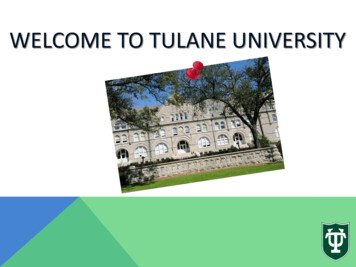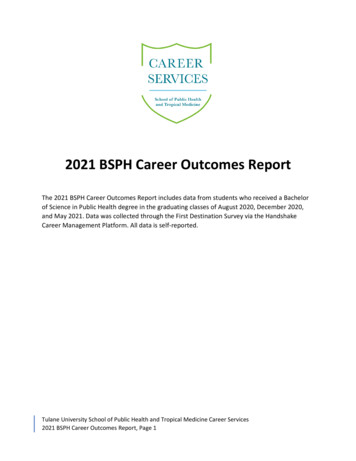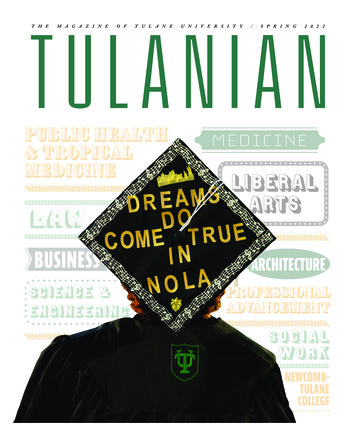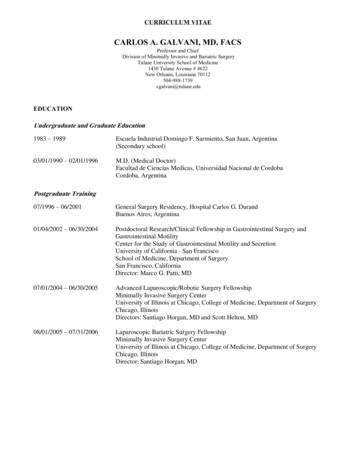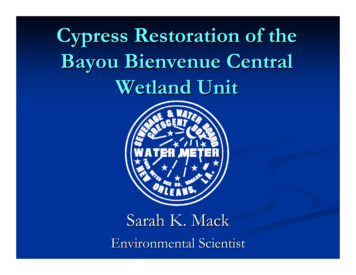
Transcription
Cypress Restoration of theBayou Bienvenue CentralWetland UnitSarah K. MackEnvironmental Scientist
Wetlands, Wastewater Infrastructure,and the Recovery Long Term Planning and Recovery ofCritical Infrastructure Wastewater Infrastructure Design UsingWetland Assimilation MultipleBenefit / Multiple StakeholderApproach Enhance 28,000 Acres of Cypress Wetlands Protect Orleans and St. Bernard ParishesSewerage & Water Board of New Orleans
Hurricane Katrina August 28-29,2005Sewerage & Water Board of New Orleans
In the presence ofextraordinary actuality,consciousness takes theplace of imaginationWallace Stevens
Sewerage & Water Board of New Orleans
Sewerage & Water Board of New Orleans
Sewerage & Water Board of New Orleans
Sewerage & Water Board of New Orleans
East Bank Sewage Treatment Plant Urgent Need for Restoration FEMA- Pre-Katrina Conditions 2 Year Time Frame for Restoration Estimated 70 Million forRestorationSewerage & Water Board of New Orleans
Facing the Future Population? Solids Nutrients Mitigation 50% Less RevenueSewerage & Water Board of New Orleans
Driving Factors of Recovery Public Safety Economic Recovery Multi-Objective Management HazardMitigation Objectives Coincidewith Stakeholder Objectives Multiple BenefitSewerage & Water Board of New Orleans
Sustainability Disaster- The ability to survive future disasterswith minimum loss of life and property Hazard MitigationEnvironment-Meet the needs of the presentwithout compromising the ability of futuregenerations to meet their own needsGlobal Climate Change Energy Sewerage & Water Board of New Orleans
Global Climate Change Adaptation of vulnerable humansystems. Need to adapt to an already-changingclimate Relative Sea Level Rise (RSLR) Increased Tropical StormsSewerage & Water Board of New Orleans
HUBBERT’S PEAKSewerage & Water Board of New Orleans
Sewerage & Water Board of New Orleans
KATRINAANDREWCAMILLEBETSYCAT 5 LEVEESAUDREYMARSH CREATION USINGPIPELINESSewerage & Water Board of New Orleans
Adaptation Measures & the Poor Enhanced natural resource measuresbenefit the poor more than large scalestructural measures! Poor are the most dependent on naturalresources. Poor tend to live in more vulnerablelocations.Source: IDNDRSewerage & Water Board of New Orleans
Sewerage & Water Board of New Orleans
Sewerage & Water Board of New Orleans
Sewerage & Water Board of New Orleans
Environment Is Our Best Asset Wetlands most productive ecosystems.Will contribute proportionally more to thehuman economy in the future.Offset impacts of global climate changeRelative Sea Level Rise Increased Tropical Storms As fossil fuels become scarce natural energieswill become more important.Sewerage & Water Board of New Orleans
Sewerage & Water Board of New Orleans
Sewerage & Water Board of New Orleans
WETLAND ASSIMILATIONSecondary atural EnergiesRestored WetlandsStorm ProtectionSewerage & Water Board of New Orleans
Wetland Assimilation Waste Assimilative Capacity Natural systems have the ability to“clean” waste up to a certainamount. Determined in feasibilitySewerage & Water Board of New Orleans
Tertiary Treatment TMDL Limits in 2010 New Infrastructure Operation and Maintenance Avoid New SpendingSewerage & Water Board of New Orleans
Thibodaux WetlandEnhancement19922003Sewerage & Water Board of New Orleans2000
Cypress Restoration of BayouBienvenue Central Wetland UnitSewerage & Water Board of New Orleans
St. Bernard ParishSewerage & Water Board of New Orleans
STBERNARDPARISH.Sewerage& WaterBoard of NewOrleans CYPRESSSWAMP AT OUTFALLOF THE GORE PUMPING STATION
Process Funding Task Force Feasibility Design ImplementationSewerage & Water Board of New Orleans
Funding DeltaRegional Authority 400,000 Feasibilityand Preliminary Design Coastal Impact Assistance Program-CIAP 10Million Phase I Implementation Implementation Funding Gap 30MillionSewerage & Water Board of New Orleans
The Nation benefitsfrom the Louisianaseafood, oil & gas, andthe port, at the expenseof our environment!Junior RodriguezSt. Bernard Parish President
Carbon Sequestration Green plants remove (sequester)carbon from the atmospherethrough photosynthesis to makebiomass in the form of roots,stems, and foliage.Sewerage & Water Board of New Orleans
Carbon Sequestration Biosequestration- above ground biomass inwood 1kg/m2 per yearCarbon Burial and Sequestration ThroughWetland Assimilation 4.6 kg/m2 per yearCentral Wetland Unit Assimilation/ Year(15,000 acres) 300,000Tons Carbon Sequestration /Yr Equivalent to 200,000 Automobiles /YrSource: Day et. al & EPASewerage & Water Board of New Orleans
Cypress Restoration of BayouBienvenue Central Wetland UnitSewerage & Water Board of New Orleans
Louisiana Wetland Loss 80% of the Nations Wetland Loss is in Louisiana34 Square Miles of Marsh Loss / Year88,000 Tons of Carbon Sequestration Equivalent to Adding 60,000Automobiles This Year 700 Square Miles of Marsh Loss in 50 Years 1.8 Million Tons of Carbon Sequestration 1.2 Million Automobiles-YearSource: www.Lacoast.gov/LandLoss/Newhistoricalland.pdf & EPASewerage & Water Board of New Orleans
Greenhouse Gas Regulation Under development by the State ofCalifornia Congress is debating the design of aFederal program Develop policy that benefits Louisiana inthe greenhouse gas offset market! Regional Greenhouse Gas InitiativeSewerage & Water Board of New Orleans
Multiple Benefits Restore Critical InfrastructureRestore 10,000-28,000 Acres of WetlandsImprove Water QualityProtect Orleans and St. Bernard ParishProtect Public HealthSequester CarbonContribute to the EconomyFinancial and Energy SavingsProtect the CultureSewerage & Water Board of New Orleans
World Model Size Recovery Policy Port Cities River-Transportation SeaLevel Rise Increased Tropical StormsSewerage & Water Board of New Orleans
Recovery RecognitionS&WB Innovative Environmental EconomicSewerage & Water Board of New Orleans
Waste is a ResourceOut of Place
References epa.gov/otaq/420f05004.htmSewerage & Water Board of New Orleans
Sewerage & Water Board of New Orleans Sustainability DisasterDisaster-- The ability to survive future disasters The ability to survive future disasters with minimum loss of life and propertywith minimum loss of life and property Hazard MitigationHazard Mitigation EnvironmentEnvironment--Meet the needs of the present Meet the needs of the present
